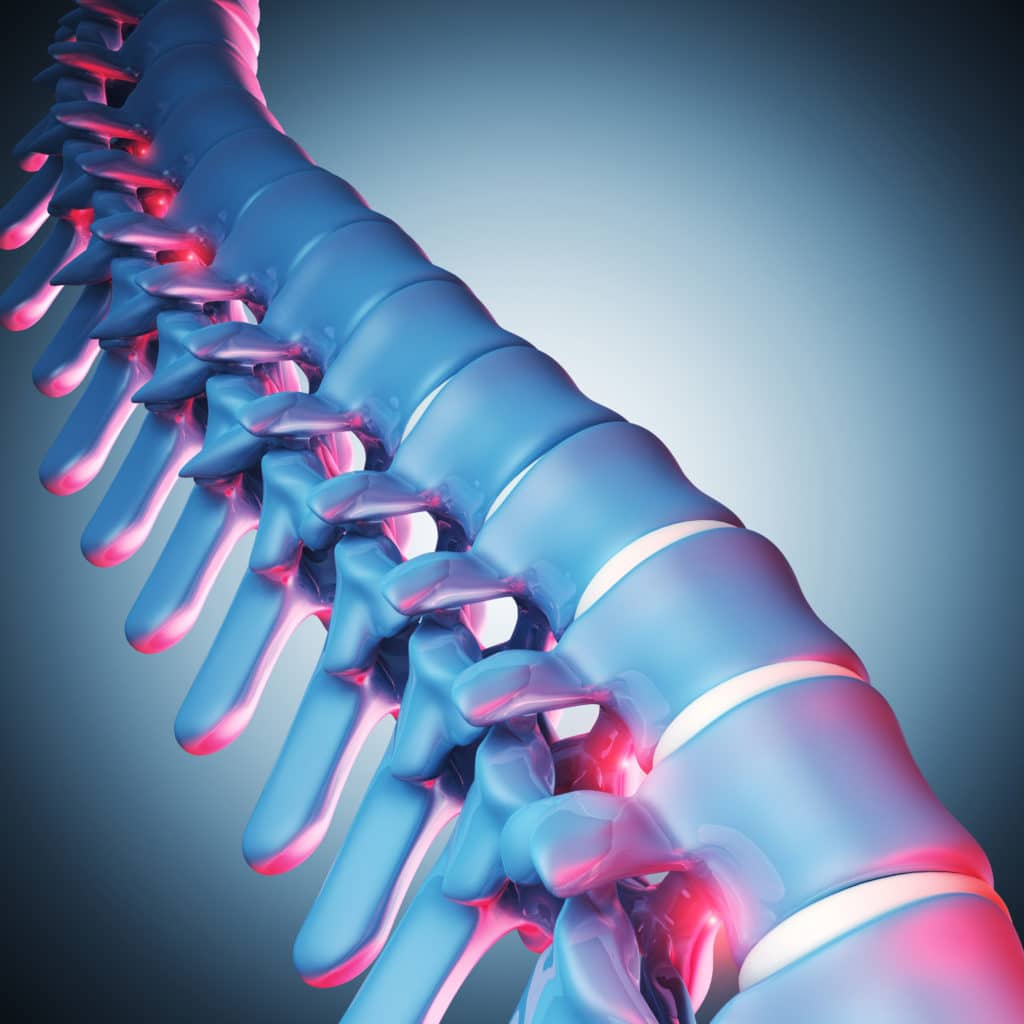What Is Anterior Cervical Decompression And Fusion Surgery (ACDF)?
ACDF is a spinal procedure that may be performed when non-surgical interventions have failed to achieve lasting pain relief in the instance of cervical radiculopathy. The objective of this surgery is to alleviate pressure on the spinal cord that has originated with bone spurs, herniated disc, or other degenerative disc disease. Dial 212-606-1004 today to schedule your ACDF consultation with the talented Mr. Todd J. Albert!

Am I A Candidate For Anterior Cervical Decompression And Fusion Surgery?
Patients for whom conservative modalities such as physical therapy and medication have not produced the desired amount of symptom relief may be good candidates for ACDF surgery. In addition to a thorough history of the neck injury itself, we will also complete a detailed medical history to confirm the patient is insufficient health to undergo neck surgery and its recovery period. Some patients may need to stop smoking or modify certain medications in order for ACDF to be considered a viable treatment option.
ACDF Procedure
There are two major parts of the Anterior Cervical Decompression and Fusion Surgery:
First, an incision is made in the lower part of the front of the neck. Underlying muscle tissue, trachea, esophagus, and carotid artery are maneuvered so the surgeon has direct access to the front of the cervical spine (the anterior aspect).
Retractors are then inserted to hold delicate structures in place while the surgeon observes the spinal segment using surgical loupes or an operating microscope.
Fluoroscopy or x-ray imaging is used to confirm the level or levels of the intervertebral spaces that need to be decompressed. Decompression is achieved by removing bone and soft tissue that are pressing down on the nerve root or roots. Space is then reconstructed to support the cervical spine.
Normal loads of the cervical spine may be reinstating with grafting that spans the intervertebral space. This consists of a combination of bone from the bone bank and local bone from the area of the spinal decompression.
In a majority of cases, Dr. Todd Albert does not take a bone graft from the patient’s iliac crest (hip area) meaning you will not have a separate incision. The second component of the fusion is the instrumentation. This is a plate and screws that are then placed anterior to the vertebrae.
ACDF Surgery Risks
Risks of Anterior Cervical Decompression and Fusion Surgery include:
- Bleeding or hematoma formation at the surgical site
- Infection
- Damage to the vertebral or carotid artery
- Chronic hoarseness caused by damage to the recurrent laryngeal nerve
- Difficult swallowing caused by damage to the superior laryngeal nerve
- Damage to the trachea or esophagus
- Cerebrospinal fluid leak or accumulation of spinal fluid beneath the incision
- Mechanical complications of titanium fixtures or grafting material
- Inadequate fusion, causing ongoing pain
- Unresolved damage to the nerve root or spinal cord, causing ongoing pain or other symptoms
ACDF Results
Overall, most patients who undergo Anterior Cervical Decompression and Fusion Surgery enjoy significant improvement. Results are maximized when surgery is performed before the spinal cord has been severely injured. ACDF surgery has been shown to halt the progression of spinal disease by removing the source of nerve compression and spinal damage. When consulting with patients, a surgeon estimates prognosis based on the severity of the existing compression.
Is Fusion Surgery Painful?
It is important to keep in mind that pain is a very subjective experience and one’s reaction to surgery is affected by a variety of factors. After ACDF surgery, the most common concerns we hear from patients are a sore throat (similar to after getting a tonsillectomy) and discomfort around their scapula (or shoulder blade). Both of these tend to resolve prior to the first post-operative appointment at 2-3 weeks after surgery.

It is not uncommon for patients to experience “reminder” pain after surgery. This is when a patient begins to experience the same symptoms as they had before surgery. While this is common in recovery from spine surgery we understand that this can be very concerning to our patients. We encourage you to call the office with any concerns you may have after surgery.
What Should I Avoid Before ACDF Surgery?
We ask that you refrain from taking any nonsteroidal anti-inflammatory medicines 10 days before and 10 weeks after surgery such as:
- Aspirin
- Advil
- Aleve
- Any herbal supplements
- Vitamin E
- Vitamin K
- Fish Oil
If you have a physician who recommends that you do not stop Aspirin prior to surgery please be sure to discuss this with our office. You should also discontinue all exposure to nicotine, as well as nicotine-containing products, two weeks before and at least 6 weeks after your surgery.
Patient Testimonial
"ANTERIOR CERVICAL DISCECTOMY AND FUSION-MY STORY
My life was making a right-hand turn to facing a high probability of living life in a wheelchair. My spine was failing and the clock was ticking. After 17 years of neck pain and limited range of motion I was referred to Dr. Todd J. Albert and my diagnosis was finally made: severe cervical myelopathy, myelomacia at C4, loss of cervical lordosis, severe spondylosis, C3- C4, C4-C5 and C5-C6, congenital stenosis, snake eye appearance of the spinal cord, spinal compression at C3-C4, C4-C5 and C5-C6, severe osteoporosis, no motion volitionally lateral bending or rotation, positive bilateral Hoffmans, and some kyphosis in the mid-cervical spine. On my initial consultation with Dr. Albert, he instilled trust, confidence and respect as his goals of care were well thought out. My case was very serious, certainly not without complications and risk. Hope and spirit were rekindled by Dr. Albert in his positive belief he could help me.
Dr. Albert performed the following surgery: anterior cervical discectomy and fusion, C3- C6 with instrumentation, posterior cervical laminectomy, C3-C6 and fusion with instrumentation and bone graft.
My surgery was a medical miracle and testament to Jean de la Bruyere’s “Out of difficulties grow miracles.”
One could describe Dr. Todd J. Albert as a gentle giant, yet a doctor and a surgeon who is very proficient and accomplished in his work. Confident with sound judgment and compassionate about his work, one could say Dr. Albert is a genius, an Amazing doctor, nothing but perfection, a doctor with honor and integrity who takes much pride in his work. I continue to think of Dr. Todd J. Albert as a Superman in my life who took over for the rescue when I was drowning with spine problems with no hope and no answers, restoring my hope and giving me answers to all aspects of my spine condition.
Dr. Todd J. Albert and Natisha Ross, PA-C for Dr. Albert are true lifesavers for a spine patient and pillars of hope. I am blessed and Dr. Albert and Natisha are blessings in my life. Miracles do happen, as one must never lose hope. I feel like a walking miracle.
On the Road Again… Life is Good… Embrace the Journey!"
Click here to view more patient testimonials.
Anterior Cervical Decompression And Fusion Recovery
During the first 2-3 weeks after you have anterior cervical decompression and fusion surgery, your activity will be limited to walking. We encourage you to walk as much as you are comfortable. You may go up and down stairs, with the use of a railing, and you may also sleep in a normal bed. You will be limited to lifting 5 pounds for the first 2 weeks.

After two weeks you will be able to resume low-impact cardiovascular activities and increase the amount of weight you are lifting. Within a reasonable amount of time, you will have very few restrictions on your activities. Please be sure to discuss any specific questions with us in the office.
The first visit is 2-3 weeks after surgery however if you have any questions or concerns please call the office. If we think we should see you in the office we will schedule an earlier appointment. Most patients do not have sutures that need to be removed after an Anterior Cervical Decompression and Fusion Surgery. There are internal sutures that will dissolve with time. There will also be steri-strips (white pieces of tape) over the incision that will either fall off or we will remove them on the office.
Please keep in mind that the recovery from surgery is quite subjective and is affected by various factors such as patient age, comorbid illnesses, the degree of the spinal cord or nerve impingement, the length of illness prior to surgery as well as the degree of disability prior to surgery to name a few.
Restrictions After Anterior Cervical Decompression and Fusion Surgery
Recovery after ACDF surgery will take time. During this time, you experience several restrictions when it comes to simple, daily tasks. Most people do not have many permanent restrictions after their ACDF procedure. However, some of the short- and long-term restrictions you may encounter include:
Swallowing: You may have difficulty swallowing for the first few days after surgery. You also do not have any restrictions on what you can drink or eat.
Phone and Computer Use: Your head weighs anywhere from 10 to 15 pounds. When you lean forward to work on the computer or lean to the side to hold the phone between your ear and shoulder, your head weighs up to three times its normal weight. Your head is designed for perfect balance when you are sitting straight up. Flexing your head forward puts additional pressure on the bones in your neck and increases the risk of requiring additional surgery after ACDF.
Driving: You will likely have a collar after ACDF surgery, you won’t be able to drive until you come out of the collar. However, once you no longer need it, there are no restrictions on driving.
Anterior Cervical Decompression And Fusion FAQs
How Long Will I Be Wearing A Soft Collar After This Procedure?
These procedures formerly involved external immobilization of the patient’s neck, however recent advances in the materials used to complement the fusion have made this mostly unnecessary. Still, a soft collar, and in rare instances a hard collar (also known as an Aspen or Miami J collar) will likely be part of your recovery.
Soft collars are used primarily for comfort, as they don’t provide rigid support. Soft cervical collars are typically worn between 2-4 weeks after surgery. The prescribed amount of time you will be wearing the collar will vary depending on the particulars of your situation and the varying factors that are taken into consideration.
How Long Will I Be Out Of Work After ACDF?

How Soon After My Surgery Will I Be Able To Drive?
You can be a passenger in a car as soon as you feel up to it.
Many patients are able to return to driving short distances, such as to the neighborhood grocery store, in 2 to 3 weeks after their surgery. Know that some patients can drive sooner, while others need more time. You should not drive while you are wearing the soft collar, which is typically discontinued through a weaning process at the first post-operative appointment.
Will I Need Physical Therapy After ACDF?

Will I Set Off Metal Detectors After Having ACDF Surgery?
The materials used for modern fusion are made of titanium. The instrumentation used for this procedure does not set off metal detectors.
Can I Have An MRI After Having ACDF Surgery?
You can have magnetic resonance imaging performed after you’ve had cervical fusion but please be sure to let the technician know that you have had an ACDF with instrumentation.
Is Anterior Cervical Decompression And Fusion Considered a Major Surgery?
Although the actual surgery usually takes from an hour to an hour-and-a-half, it is still considered major surgery, especially because the spine is a central focus of the procedure. Despite this fact, we encourage patients not to feel intimidated by the notion of a major surgery. Preparing ahead of time, asking any remaining questions, and working closely with Dr. Albert can help ensure a complication-free and successful procedure.
What Is the Success Rate of ACDF Surgery?
The success rate for ACDF surgery is relatively high. Between 93 and 100 percent of ACDF patients who suffered from years of arm pain reported long-lasting relief. 73 to 83 percent of ACDF patients report relief from neck pain as well. While this relief will vary from patient to patient, the amount of relief you feel and when you feel it will depend on the severity of the damage to your neck and spine.
Schedule An ACDF Consultation In NYC!
For more information on ACDF surgery or to determine whether you are a candidate for the procedure, be sure to schedule a consultation with New York City Spine Surgeon Dr. Todd J. Albert. Call 212-606-1004 or go to our contact page to fill out an appointment request form. Our practice looks forward to serving you!


